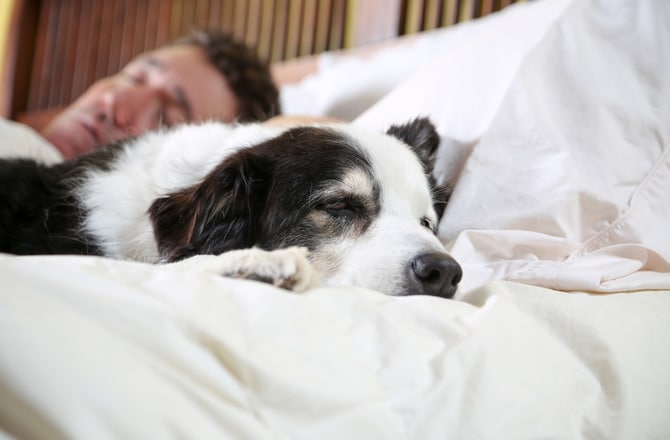6 Reasons Your Dog Is Depressed

The unconditional love dogs show their owners is a constant source of joy. And it’s reliable: Dog owners know they can walk through the door after a long day at work and have their pup shower them with kisses while she barks, cries, and jumps excitedly and almost uncontrollably. There’s nothing quite like that feeling, which makes the rare occasions when your dog reacts in a more subdued way—or doesn’t react at all—stand out so much.
Depression isn’t typically diagnosed in dogs, but veterinarians and behaviorists know the signs of depressive behavior well. Jane Bowers, a certified dog trainer and certified canine behavior consultant, says symptoms of depression in dogs include becoming withdrawn, no longer participating in things he or she used to like to do, becoming inactive, sleeping more, and being less interested in food.
But because we can’t ask dogs why they’re behaving this way, it’s important to pay attention to the context around this behavior and know the common causes. Here are six reasons why your dog might be acting depressed.

Lack of Attention
There’s a reason why dogs are often saddest in the morning before you leave for work and happiest when you walk in the door after—they want to be around you. “Dogs are social animals and love to be with people,” says Carol Sumbry, a certified dog trainer and associate certified behavior consultant. “Many are left alone long hours without access to human contact, access to bathroom facilities, or an outlet for their energy or natural instincts.”
This, Sumbry says, can lead to depressive behavior, but for many owners, there’s not much they can do about their job schedules. That’s why it’s important to spend quality time with your dog when you can, and that can take many different forms, including physical activity, mental stimulation, brushing, petting, or any other number of activities.
But Bowers says when a dog begins to behave in a depressive way, he or she might stop doing some things they enjoy, but not others. She says owners should latch on to the behaviors they still show interest in. Don’t force them to do something they don’t want to do, even if it previously excited them. That might make matters worse.
If the time you are able spend with your dog doesn’t seem sufficient, consider hiring a dog walker or asking a friend to stop by while you are gone.

Not Enough Exercise
Physical stimulation is important for a dog’s overall health, but Sumbry says your dog’s exercise routine must also sufficiently meet his or her emotional needs. “A fenced-in yard can’t replace a regular walk with new smells and sights and sounds,” she says.
Sumbry says a good baseline for exercise is a total of five miles of walking per week, but that varies from dog to dog depending on his or her age and energy level. It’s more important to let your dog take her time and enjoy the surroundings, she says, even if that means you just do one block over 20 or 30 minutes.

Death of a Family Member or Fellow Pet
Kathi O'Malley, an associate certified dog behavior consultant, says this is one of the most common reasons for depressive behavior in dogs. Unfortunately, it’s also probably the most difficult to deal with because the source of the behavior is irreplaceable.
In the case of losing another pet in the house, O’Malley says some respond well to the addition of a new pet, while others will remain depressive, wanting only the company of the one who’s gone.
As for the loss of a human family member, Sumbry says research has shown that a dog’s bond with her owners is similar to a baby’s bond with her parents. Other family members need to step up wherever possible to meet the dog’s physical and especially her emotional needs, in tragic situations like this.

That dog-owner bond goes beyond loss, and Sumbry says one study has shown that dogs can tell whether we are happy or sad by our facial expressions.
“Dogs are also being used to detect low blood sugar in diabetics, as well as cancer. They certainly can tune into people and our subtle changes in body language and emotion, so they can be impacted by a family member’s depression,” she says. “We can’t fool our dogs. They are very in tune with our emotions.”

Behavior Correction
The way you train your dog may lead to depressive behavior, Bowers says. “Dogs who are corrected for unwanted behavior may soon stop offering behaviors at all in order to avoid punishment,” she says.
Sumbry adds that using things like shock collars or other extreme forms of punishment may lead to a state of mind known as learned helplessness that can be associated with depression. “This occurs when people or animals feel helpless to avoid negative situations,” she says. “In studies, dogs no longer tried to escape shocks if they had been conditioned to believe they couldn’t escape.”
Instead of punishing for “poor” or “negative” behavior, Bowers recommends rewarding for good behavior. “Dogs trained with rewards are often more confident and attentive to their owners than those who are punished,” she says.

Medical Problems
Withdrawing, not eating, lethargy—in addition to being indicative of depressive behavior—may also be symptoms of medical problems.
Sumbry lists arthritis, thyroid issues, and dental problems as common issues that should be discussed with a veterinary professional if your dog is behaving in a way you might describe as depressed. “If you can then rule out a medical problem, you can start focusing on your and your dog’s lifestyle to find ways to make her feel better,” Sumbry says.
Source: PetMD, LLC
4244 Madison Avenue, Trumbull, CT 06611
© 2016-2022 Wet Paws Dog Grooming, LLC. All rights reserved.
